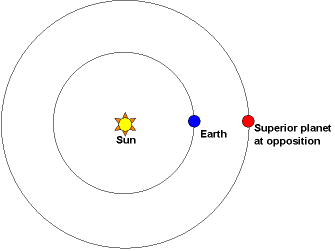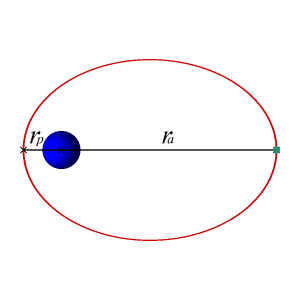

Jupiter as seen by amateur astronomer Anthony Wesley on May 19, 2019. Image via Anthony Wesley.
Jupiter’s opposition happens on July 14, 2020 at 08:00 UTC. At opposition, Earth in its orbit flies between Jupiter and the sun, placing Jupiter opposite the sun in our sky. You’d think Jupiter would be closest to Earth on the day of opposition. But it isn’t. Jupiter doesn’t come closest to us for the year 2020 until July 15 at 10:00 UTC. The least distance between Earth and Jupiter this year will be 385 million miles (619 million km).
Why isn’t Jupiter closest to Earth on the day Earth goes between Jupiter and the sun?

Opposition happens when Earth flies between an outer planet, like Jupiter, and the sun. Why aren’t Earth and Jupiter closest on the day of opposition? Illustration via Heavens-Above.
Jupiter and Earth would be closest on the day of opposition, if the orbits of Earth and Jupiter were perfect circles and if our two worlds orbited on the same exact plane. Both Earth and Jupiter have orbits that are very nearly circular. They go around the sun on almost the same plane. But – in both cases – not quite.
Consider that, because Jupiter’s orbit is elliptical, not circular, Jupiter’s distance from the sun varies.
Likewise, Earth’s orbit is elliptical, not circular. Our distance from the sun varies, too.

This animation shows an orbit that’s vastly more elliptical than either Earth’s or Jupiter’s. Still, you get the idea. Perihelion = closest to sun. Aphelion = farthest from sun. Image via Brandir/ Wikipedia.
Jupiter’s orbit takes 11.9 Earth-years. Earth’s orbit takes one year.
Right now, we’re headed toward a perihelion – or closest point to the sun – for Jupiter. In other words, every single day, Jupiter is closer to the sun than it was the day before. Are you beginning to see how it can be closer to Earth after we go between it and the sun?
Not yet? Keep reading …
Jupiter passed aphelion – its farthest point from the sun in its orbit – on February 18, 2017. Jupiter will reach perihelion – its closest point – on January 25, 2023.
So Jupiter is getting closer to the sun each day. And what is Earth doing?
Earth’s perihelion happens every year in early January. So Earth is getting a bit closer to the sun each day now.
Jupiter is now getting closer to the sun – bit by bit, closer and closer – every earthly day. And Earth is getting closer to the sun – bit by bit, closer and closer – every day. Yet Earth’s change of distance (relative to the sun) is small compared to Jupiter’s. So Jupiter makes a small gain on Earth between July 14 and 15, 2020. After July 15, 2020, the gap between Earth and Jupiter widens again.
And that’s how Jupiter and Earth can be closest for 2020 on the day after our planet passes between Jupiter and the sun.
Understand? If not, check out these two links … or let’s talk in the comments below …
Geocentric ephemeris for Jupiter: 2020
Geocentric ephemeris for sun: 2020
Here are those numbers again:
Jupiter’s opposition July 14 at 08:00 UTC (June 14 at 3 a.m. CDT).
Jupiter closest July 15 at 10:00 UTC (June 15 at 5 a.m CDT).

Another artist’s concept of Jupiter and Earth at opposition, when Earth passes between the sun and Jupiter.
Bottom line: You’d think Jupiter would be closest to Earth on the day we pass between it and the sun. But, in 2020, Jupiter’s opposition comes the day before its closest point to Earth. Why?
Read more: We go between Jupiter and the sun July 14, 2020
from EarthSky https://ift.tt/38SOSyc


Jupiter as seen by amateur astronomer Anthony Wesley on May 19, 2019. Image via Anthony Wesley.
Jupiter’s opposition happens on July 14, 2020 at 08:00 UTC. At opposition, Earth in its orbit flies between Jupiter and the sun, placing Jupiter opposite the sun in our sky. You’d think Jupiter would be closest to Earth on the day of opposition. But it isn’t. Jupiter doesn’t come closest to us for the year 2020 until July 15 at 10:00 UTC. The least distance between Earth and Jupiter this year will be 385 million miles (619 million km).
Why isn’t Jupiter closest to Earth on the day Earth goes between Jupiter and the sun?

Opposition happens when Earth flies between an outer planet, like Jupiter, and the sun. Why aren’t Earth and Jupiter closest on the day of opposition? Illustration via Heavens-Above.
Jupiter and Earth would be closest on the day of opposition, if the orbits of Earth and Jupiter were perfect circles and if our two worlds orbited on the same exact plane. Both Earth and Jupiter have orbits that are very nearly circular. They go around the sun on almost the same plane. But – in both cases – not quite.
Consider that, because Jupiter’s orbit is elliptical, not circular, Jupiter’s distance from the sun varies.
Likewise, Earth’s orbit is elliptical, not circular. Our distance from the sun varies, too.

This animation shows an orbit that’s vastly more elliptical than either Earth’s or Jupiter’s. Still, you get the idea. Perihelion = closest to sun. Aphelion = farthest from sun. Image via Brandir/ Wikipedia.
Jupiter’s orbit takes 11.9 Earth-years. Earth’s orbit takes one year.
Right now, we’re headed toward a perihelion – or closest point to the sun – for Jupiter. In other words, every single day, Jupiter is closer to the sun than it was the day before. Are you beginning to see how it can be closer to Earth after we go between it and the sun?
Not yet? Keep reading …
Jupiter passed aphelion – its farthest point from the sun in its orbit – on February 18, 2017. Jupiter will reach perihelion – its closest point – on January 25, 2023.
So Jupiter is getting closer to the sun each day. And what is Earth doing?
Earth’s perihelion happens every year in early January. So Earth is getting a bit closer to the sun each day now.
Jupiter is now getting closer to the sun – bit by bit, closer and closer – every earthly day. And Earth is getting closer to the sun – bit by bit, closer and closer – every day. Yet Earth’s change of distance (relative to the sun) is small compared to Jupiter’s. So Jupiter makes a small gain on Earth between July 14 and 15, 2020. After July 15, 2020, the gap between Earth and Jupiter widens again.
And that’s how Jupiter and Earth can be closest for 2020 on the day after our planet passes between Jupiter and the sun.
Understand? If not, check out these two links … or let’s talk in the comments below …
Geocentric ephemeris for Jupiter: 2020
Geocentric ephemeris for sun: 2020
Here are those numbers again:
Jupiter’s opposition July 14 at 08:00 UTC (June 14 at 3 a.m. CDT).
Jupiter closest July 15 at 10:00 UTC (June 15 at 5 a.m CDT).

Another artist’s concept of Jupiter and Earth at opposition, when Earth passes between the sun and Jupiter.
Bottom line: You’d think Jupiter would be closest to Earth on the day we pass between it and the sun. But, in 2020, Jupiter’s opposition comes the day before its closest point to Earth. Why?
Read more: We go between Jupiter and the sun July 14, 2020
from EarthSky https://ift.tt/38SOSyc

Aucun commentaire:
Enregistrer un commentaire